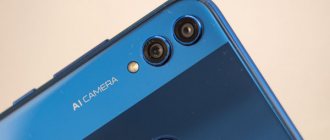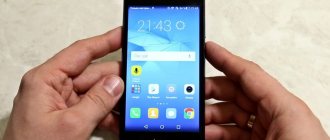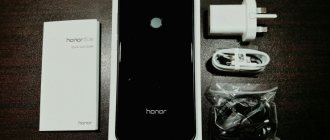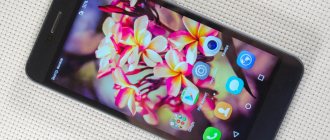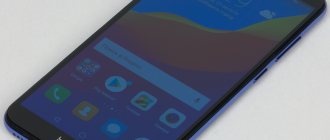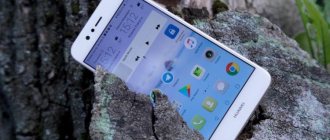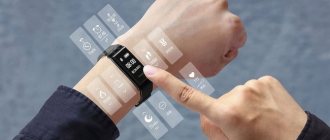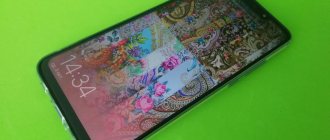Huawei Mate 9 Pro is an intermediate model between the Mate 9 and Porsche Design, which were presented in the fall of 2016. With the release of such gadgets, Huawei proves how much the company has grown in recent years. A premium device with a beautiful design, the latest hardware and well-optimized software - all this speaks for itself. The editors of the GSMArena portal prepared a review of this smartphone, and we translated it for our audience.
Subscribe to our Zen
Specifications
- Screen: 5.5 inches, AMOLED, 534 ppi, 2560×1440 pixels, Gorilla Glass 3.
- Operating system: Android 7.0 Nougat (Huawei EMUI 5.0).
- Processor: Kirin 960, eight-core: 4×Cortex-A73 (2.4 GHz) + 4×Cortex-A53 (1.8 GHz).
- GPU: Mali-G71 GPU, eight-core.
- RAM: 6 GB.
- Built-in memory: 128 GB, no microSD card slot.
- Main camera: dual Leica certified - 20 MP (monochrome sensor) and 12 MP (color sensor); f/2.2, 4-in-1 hybrid autofocus, dual LED flash; Video recording 2160p at 30 FPS and 1080p at 60 FPS.
- Front camera: 8 MP (f/1.9), 1080p video recording at 30 FPS.
- Battery: 4,000 mAh, lithium polymer, non-removable.
- Dimensions: 152×75×7.5 mm.
- Weight: 169 g.
- SIM slots: 2 nanoSIM.
- Communications: LTE-A (up to cat. 12, 600 / 150 Mbit/s), USB Type-C, Wi-Fi a/b/g/n/ac, GPS / GLONASS / Beidou / Galileo, IR port, no FM radio.
- Sensors: light, gravity, proximity, gyroscope, digital compass, fingerprint sensor.
- Available colors: gold and black.
- Cost at the time of testing: about 50 thousand rubles on the gray market.
Compared to the regular Mate 9 (5.9 inches), the display is significantly smaller, but it is curved at the sides. Thanks to this, the Mate 9 Pro can be called a regular smartphone, and not a huge phablet. Many will be disappointed by the lack of a microSD card slot, but this is compensated by the presence of 128 GB of memory. There is also no protection against water and dust, as in other Huawei products - the company is still ignoring this technology.
KV.by
The Chinese company Huawei is moving more and more confidently in the mobile device market every year. And if previously the goals were set to oust competitors from the country and seize a share in emerging markets in the budget and mid-range segments, today the manufacturer’s ambitions have grown to the premium segment already in world, including Western markets.
The “Chinese” have long been offering the same current computing power and screen inches at a lower cost, but recently they have ventured into competition for the brand. You don’t need to go far for examples; the same company Huawei, actively cooperating with Europeans in terms of photo modules, design, etc., is trying to step on the heels of such giants as Samsung and Apple. For now, such attempts cause cautious bewilderment, but, knowing the ambitions of the Celestial Empire, give it time!
Huawei Mate 9 smartphone, which recently excited the public, was tested .
Appearance, design
The smartphone comes in a strict, rigid cardboard box with wall thicknesses from 2 to 4 mm. The design of the box is not flashy, but you can immediately see that there is something not budget-friendly inside.
The smartphone is located in the recess of a special mold, behind it are two neat cases with the delivery kit (power adapter, USB type A-USB type C interface cable, stereo headset, key for removing the SIM card slot/memory card, micro USB type B- adapter USB type C, plastic protective bumper, set of paper documentation).
In general, the packaging and accessories immediately put you in a serious mood - everything is sound, thorough, with attention to seemingly small, but important details.
In your hands is a 5.9-inch smartphone in a metal case. Not even turning it on yet, you understand - this is a flagship!
The body is smooth, slightly slippery, and pleasantly cools the palm. The contour lines are soft and smooth. However, the manufacturer did not completely “lick” the body - yes, the corners are rounded, but the transitions from the main edges to the side edges are decorated with small chamfers, and the protective glass with a thin plastic frame around the perimeter, covering the entire front side, also protrudes slightly above the body.
By the way, the smartphone body is not all-metal - a signal must pass through the antennas with transceivers located inside. Therefore, small plastic inserts, 6 mm wide, are noticeable on the top and bottom of the rear edge. Then there's metal everywhere.
On the front side from the plastic glass frame to the screen there is 9 mm at the top and 12 mm at the bottom of the free space. At the top, in the center, there is a speaker, covered with a recessed mesh, to the right of it is a window for proximity and brightness sensors, and even further away is the front camera lens and an LED indicator. The main navigation buttons (Back, Home, Menu) on the smartphone are on-screen, so only the manufacturer’s logo is located under the screen.
The back edge of the device out of the box is covered with a transparent protective sticker with technical information and explanatory notes. Thanks to it, by the way, you can find out, without turning on your smartphone, on which side the multimedia speaker is located, on which side the microphone is located, how the SIM cards are configured by default, or what kind of hole is actually located above the photo module. Useful, yes.
The central element on the reverse side is a photo module from Leica with two lenses, to the left of it is a two-color LED flash, to the right is a laser autofocus window, and at the bottom is a fingerprint scanner. The already mentioned small hole above the photomodule is an NFC sensor.
The side edges of the smartphone contain standard controls and switching controls: on the left is a tray for installing SIM cards (nano format) and memory cards (the slot for SIM2 is combined with a slot for a micro SD card), on the right are the power/lock and volume buttons, on the bottom – a USB type C port framed by perforations, behind which the multimedia speaker and microphone are hidden; on top there is a 3.5 mm jack for connecting a headset and (bonus) an IR sensor window.
Hardware platform, performance
Specifications are given from the manufacturer's website:
— model: MHA-L29;
— overall dimensions and weight: 156.9x78.9x7.9 mm, about 190 g;
— color: Space Gray/Moonlight Silver/Champagne Gold/Mocha Brown/Ceramic White;
— display: 5.9″, resolution 1080p (1920×1080), 373 ppi, 16.7M colors, High contrast 1500:1;
— processor: Huawei Kirin 960, Octa-core CPU (4 cores 2.4 GHz A73 and 4 cores 1.8 GHz A53) + i6 co-processor, Mali-G71 MP8 video chip;
— RAM: 4 GB;
— built-in memory: 64 GB;
— memory card support: micro SD, up to 256 GB;
— operating system: Android 7.0;
— communication: SIM1 – 4G/3G/2G; SIM2 – 3G/2G;
— navigation: GPS/Glonass/Galileo/BDS;
— communications: WLAN 802.11 a/b/g/n/ac, Bluetooth 4.2, NFC, USB, infrared;
— main camera: 20 MP Monochrome + 12 MP RGB, F2.2;
— main camera features: optical stabilization, BSI CMOS, 2x hybrid zoom;
— front camera: 8 MP AF, F1.9;
— video support: 4K video, H.265, H.264, H.263, MPEG-4, MPEG-2, RV7-10, Xvid, VP8, WMV9 (video decoding formats); 3GP, MP4, WMV, RM, RMVB, ASF (video file formats);
— audio support: MP3, MIDI, AMR-NB, AAC, AAC+, eAAC+, AMR-WB, WMA2-9, RA, PCM, OGG, and FLAC (audio decoding formats); MP3, MP4, 3GP, WMA, OGG, AMR, AAC, FLAC, WAV, MIDI, RA (audio file formats);
— Battery: 4000 mAh.
Yes, the technical characteristics are impressive, but that's an understatement. Or rather, not enough. The fact is that the Kirin 960 processor uses the most current technologies today: Cortex-A73 cores, UFS 2.1 memory and a Mali G71 MP8 video accelerator were used for the first time. According to the manufacturer, the processor turned out to be “the very best”: compared to its predecessors, there is a 10% increase in performance in the single-core test and 18% in the multi-core test, a 150% increase in RAM speed (read/write), a 180% increase in video adapter performance, At the same time, a reduction in energy consumption by 15-20% was achieved. It is clear that the processor supports so many interfaces, functions and technologies that their description deserves a separate interesting article.
After such assurances, you don’t expect anything from synthetic tests other than, if not excellent, then at least confident results. Expectations are met.
Talking about the quick operation of the interface, smooth window switching and proper operation of everyday applications is hardly appropriate with such hardware “on board”, but to note the fact that the smartphone actually supports 4K video playback and the correct operation of all applications “downloaded” from the Play Market virtual reality and modern video games are worth it.
Software usage and functionality
The smartphone has traditionally been in personal use for a week, after which we can say the following.
After the habit of everyday use of a 5" smartphone, Huawei Mate 9 does not look very bulky in the hands. Fingers quickly adapt to the dimensions, and the slightly sliding metal body, however, remains in the hands due to the combination of weight, decent width and small thickness of the device. The included plastic bumper-case is designed to finally overcome the user's possible doubts regarding the confident positioning of the device in the hand, which, however, is easier to put on than to take off. It’s another matter when the smartphone ends up in your pocket and sticks out of it - here they are, almost 6 inches.
The smartphone has a high-quality display. The viewing angles are excellent, the colors are rich, quite deep, and the contrast is good. In addition, in the settings you can change the automatic brightness setting to manual, change the color temperature and even activate the eye protection mode by reducing the ultraviolet radiation of the screen.
Touch input (ten-point) is well balanced, no incorrect actions were noted.
Both speakers of the smartphone produce good sound: the confident, clear voice of the interlocutor is heard from the conversational speaker, the sound of audio and video content by the multimedia speaker is also not satisfactory - clean, without extraneous noise or rattling. But the smartphone does not have full stereo sound - there is only one multimedia speaker. The situation is partly saved by the earpiece, which helps the multimedia by reproducing high frequencies, but for a flagship this is probably not the best solution.
The fingerprint scanner not only performs a protective function, but is also convenient from an ergonomic point of view - unlocking a smartphone with it is one action (scanning), and in the traditional way - two (pressing the lock button, then swiping across the screen). The settings related to the fingerprint are clear, registration is not difficult. You can register up to 5 fingerprints.
The main feature of the smartphone, the dual main camera, left only positive emotions – maybe not so much with the quality of the resulting photos and videos (and they are at a very high level for a mobile device), but with its functionality. There are just so many settings, functions and capabilities, it’s most likely impossible to understand all the intricacies “at once”, okay, there are tips and explanations.
The first launch of the camera is accompanied by a small “educational education”.
As indicated, the Modes panel appears on the left, Settings on the right, and Pro mode at the bottom. In addition, several switches are located on top of the viewfinder window.
The principle of operation of a dual camera is no longer so innovative (used in Huawei P9), but is still interesting: a monochrome camera takes a picture, and colors from the second camera are superimposed on the resulting frame. As a result, the pictures come out more detailed and contrasty.
The maximum image resolution (4:3) of the main camera is 5120x3840, video recording can be done in UHD 4K format.
However, there are some restrictions. So, turning on the HDR mode automatically resets to 12 megapixels, the same thing happens if you activate some functions when recording video (optical stabilization, for example). It’s a rare result when, at maximum settings on a smartphone in auto mode, pictures without HDR turned out not only more interesting, but also of better quality. Examples of photos are shown below:
Auto mode
HDR
Auto mode
HDR
Video Full HD 60 fps:
Within certain limits, zooming occurs without loss of quality.
No zoom
using zoom
No zoom
Using zoom
The camera allows you to shoot in fast and slow motion, and in the latter case, you can use the smartphone software to select the time interval where to slow down.
The front camera is also functional, but the emphasis is more on image post-processing. The maximum image quality (4:3) is 3264x2448, video recording is in FHD 1080p format.
Among the hardware features of the smartphone, it remains to note the capacious 4000 mAh battery and characterize the autonomy of the device. With alternating idle and active loads in the form of virtual reality applications, games and surfing the Internet, the battery lasted for two days. Active video and photo shooting discharged the device from 70% to 10% in 7 hours.
As always, there are several software solutions available to reduce power consumption.
Standard charging (5 V, 2 A) replenishes 50% of the charge in 1 hour.
Let's move on to the software part of the smartphone.
The device runs on Android 7.0 OS, on top of which the proprietary EMUI 5.0 shell is installed. The interface is familiar and understandable, but there are also some new “tricks” (the vast majority of them are convenient).
There are a lot of settings, so we will only note the highlights that we liked.
So, there is a smart unlocking via Bluetooth devices, standard tools allow you to not only take a screenshot of the screen, but also record a video from it, an interesting clone function is when you can simultaneously log in to the same application (messenger, for example) under different accounts, It is very convenient to change the combination of on-screen buttons or change the desktop style.
There are very few pre-installed applications, which will please supporters of minimalism:
- standard Google applications;
— a selection of tools, among which it is worth highlighting the Compass (works immediately without any calibration) and the Virtual Remote Control;
— Phone manager – optimization of memory, energy consumption, antivirus, traffic control, blacklist;
— HiCare – Huawei after-sales service;
— Health – in favor of the fashionable trend of maintaining a healthy lifestyle with the help of smart devices.
In this case, subjectively, there is an abundance of non-volatile memory. And this without installing a memory card.
Conclusion
After a week of use, we can say the following about the Huawei Mate 9 : “I like EVERYTHING, but why is it so expensive?” It’s clear that these are emotions, because the answer is obvious: “That’s why it’s expensive, because I like EVERYTHING.” The flagship after all.
Equipment
Huawei Mate 9 Pro comes in packaging that leaves no doubt about the premium nature of the gadget. Opening the beautiful black box with the Huawei and Leica logos, we are immediately presented with the smartphone itself in all its glory. Below it, in two compartments, there is a powerful 22.5 Watt charger, a proprietary USB Type-C cable, an adapter from microUSB to USB Type-C, headphones, a SIM card ejector and a silicone case.
Appearance
Left - Mate 9 Pro, right - Mate 9
Despite the fact that the Huawei Mate 9 Pro does not receive the Porsche Design nameplate on the front panel, the smartphone still boasts a stylish appearance. The display, curved on the sides, immediately attracts attention. Together with the Home button on the front panel, the result is almost an exact copy of the Samsung Galaxy Note 7. Huawei’s desire to lure away the audience of Samsung phablets is quite logical, because the last model in the Galaxy Note line was, to put it mildly, a failure.
Left - Mate 9 Pro, right - Galaxy S7 Edge
There is a large 5.5-inch screen on the front panel. Above it is a speaker. A light sensor is hidden under its mesh. To the left of the speaker grid is a small black dot called the proximity sensor. There is also an LED sensor for notifications and a front 8-megapixel camera.
Below the screen are three pressure-sensitive Android control buttons. In the middle is the Home button, which is not a button at all. You can't press it - it's a small touch screen that responds to taps. A very fast fingerprint scanner is integrated into this “button”.
The Home button can be customized to your liking. For example, you can turn off the two illuminated buttons on the sides and leave only one. Using it, you can perform the actions of the other three: one tap goes back, a long tap goes to the desktop, a gesture to the left or right will open a list of recent applications. Made in the style of the Meizu mTouch button, but only even better.
On the left side there is a tray for nanoSIM cards, on the right there are buttons for volume control and locking. There is only one infrared sensor on the top side, but the bottom is quite crowded: a USB Type-C port, a speaker grille and a 3.5 mm analog audio jack.
And finally, two camera sensors are located vertically on the back cover - a 12-megapixel color and a 20-megapixel monochrome. They are helped by a laser and a two-tone flash.
While the front panels of the Mate 9 Pro and Galaxy S7 edge are almost identical, the back covers are completely different. All because of the dual camera and plastic strips for antennas. The latter resemble HTC flagships. The back panel material is also completely different, even compared to the regular Mate 9 - it's polished metal with a “cleaned” texture. It is very pleasant to hold the device in your hand.
From a design point of view, Huawei Mate 9 Pro is far from original, but the Chinese have worked hard on the body materials and ease of use - all of this is top notch.
⇡#Camera
Huawei Mate 9 is the second smartphone after the P9 to have “Leica” written on it. Moreover, here we have already established the second fruit of the joint creativity of the German and Chinese companies - whatever this co-creation may be (there is a suspicion that this is a purely image move). Unlike the module used in the P9, here, paired with a 12-megapixel RGB sensor, a monochrome sensor is not of the same resolution, but 20 megapixels. The optics have not changed - “SUMMARIT-H” is written on lenses with an equivalent focal length of 27 mm and an aperture of ƒ/2.2. At a minimum, Leica issued its license to these lenses.
However, you can argue as much as you like and demonstrate your skepticism about the participation or non-participation of photography gurus in the development of mobile cameras for Huawei, but the first pancake came out at least not lumpy - the P9 camera confidently entered the pantheon of the best of last year, and the same module , used in Xiaomi M5s Plus, performed much worse. It’s all the more interesting to look at the second iteration of the new generation of dual Huawei/Leica cameras.
| Huawei Mate 9, camera app interface | ||
The interface, first shown in P9, has been preserved - the fonts are in place, and calling different menus by swiping sideways on the screen, and special color schemes. Several new shooting modes have been added to this: audio notes for photos, text recognition and watermarks.
The main innovation, in my opinion, was not the 20-megapixel monochrome sensor, but the appearance of an optical stabilizer, due to which, in fact, the module protrudes slightly above the body. This is precisely what Huawei P9 and Honor 8 lacked in order to call their cameras unambiguously the best last year.
| Operation of the “hybrid” zoom in daylight (2x and 3x zoom) | |||
In addition, the manufacturer announced a “hybrid” zoom added to the camera, allowing for up to six times magnification while maintaining resolution. What its hybridity is is not explained, nor is the principle of its operation, but taking into account the use of two lenses of the same focal length, the absence of a built-in optical zoom and the fact that the zoom only works when the 12-megapixel mode is activated, we can assume the following. The camera uses information from a 20-megapixel monochrome sensor to create (or rather “invent” by duplicating pixels) an image of even higher resolution, and then cuts out the required piece from it with a resolution of 3968 × 2976. The technique is called supersampling and allows, under ideal conditions, to create an image that the detailing is really similar to the real thing. With the slightest deterioration in conditions, a drop in detail and loss of color details are noticeable.
| Operation of “hybrid” zoom in artificial light (2x magnification) | ||
In the above example, of course, the first thing that catches your eye is the difference in viewing angle, which is inevitable for shooting from different distances, as was done here, but pay special attention to the changed (not for the better) white balance and the sharply increased level noise This, of course, is not a classic digital zoom due to a rough crop of a fragment, but this technology cannot be called breakthrough either. With higher magnification, the problems are aggravated exponentially - it is better not to use more than twice the magnification.
Autofocus is also hybrid, but without the quotation marks - both phase sensors and contrast sensors with laser clarification of distances are used. It works quite quickly, but, unfortunately, from time to time it makes mistakes in simple situations. There is no critical mass of errors, but I can’t call his work ideal.
In the review of Xiaomi Mi5s Plus, there was already a head-to-head comparison of the dual camera of this device with the camera of Huawei Mate 9 - I propose to compare it with the competing Chinese here too. We are also preparing a more detailed comparison of this camera with the cameras of the LG V20 and Apple iPhone 7 Plus - and will publish it in a separate material.
| On the left is a photo taken on Xiaomi Mi5s Plus, on the right is a photo taken on Huawei Mate 9 | ||
| On the left is a photo taken on Xiaomi Mi5s Plus, on the right is a photo taken on Huawei Mate 9 | ||
| On the left is a photo taken on Xiaomi Mi5s Plus, on the right is a photo taken on Huawei Mate 9 | ||
| | | |
| On the left is a photo taken on Xiaomi Mi5s Plus, on the right is a photo taken on Huawei Mate 9 | ||
The Mate 9's camera is truly impressive. The advantages of the previous iteration have been preserved: honest, soft colors; very well implemented black and white mode; wider dynamic range compared to all competitors. But now an optical stabilizer has been added to this, allowing you to count on higher quality shooting in low-light conditions. The camera previously made it possible to obtain more details due to the monochrome sensor, but now this is not hampered by blur due to too long shutter speeds, and the detail has increased due to the 20-megapixel resolution. In terms of all its qualities, the Mate 9, in my opinion, is the best mobile camera in the world that currently exists. The signature background blur, by the way, is also in place - but it works, as before, rather clumsily.
Huawei Mate 9-gallery
View all images (24)The smartphone can shoot 4K video - confidently, but without much brilliance.
The front camera is not bad - 8 megapixels, with autofocus. I wouldn't say it takes wide-angle camera shots with a tiny sensor to the next level, but it can add a little precision and sharpness to self-portraits, especially in the case of group selfies. In general, the picture is quite decent; the front camera is usable even in mediocre lighting.
Autonomous operation
Huawei Mate 9 has a 15.2 Wh battery (4000 mAh, 3.8 V) - the same as on the Mate 8. Even with very active use, it is at least difficult to discharge the Mate 9 during a working day. I won’t say it’s impossible, but I couldn’t do it. In quiet mode, the battery lasts for more than a day.
In our traditional test with HD video playback at maximum brightness with Wi-Fi turned on and auto-update, the smartphone lasted almost seven and a half hours, which is an excellent result for a device with a six-inch screen. It may be inferior to the Mate 8, but only slightly.
The Mate 9 is charged using the USB Type-C port and supports Huawei Supercharge technology, which allows you to charge the smartphone by about half in 20 minutes. However, we did not have the opportunity to check the marketing claims - such results can only be achieved with a proprietary charger, and the device arrived to us for testing without a charger. With chargers from other manufacturers (including those delivering the required current of 5 A), the Mate 9 was half charged in about 45-50 minutes. And completely - in about two hours.
Display
The 5.5-inch AMOLED matrix with curved edges is the key feature of the gadget. The screen is 0.4 inches smaller than the regular Mate 9, but the resolution has increased to 2560x1440 pixels and with it the pixel density to 534 ppi.
The matrix shows very good test results. For example, the average color difference value (DeltaE) is 3.8, but the colors themselves are not as sharp. Blues and reds stand out more (Delta E 8.1).
Contrast is high, as you would expect from an AMOLED at a maximum brightness of 366 nits. Another positive point is the low brightness threshold - only 4 nits. This will allow you to read comfortably in dark rooms.
Unfortunately, although the matrix in the Mate 9 Pro is created using AMOLED technology, the pixels in the pure black picture are not completely turned off. Now this is done in many gadgets, mainly so that the matrix does not burn out. Overall, the Mate 9 Pro's screen is slightly worse than the original model.
The contrast ratio in sunlight is a little disappointing, but by and large the display performs well outdoors. If you also use a proprietary film to reflect sunlight, then it’s generally at the level of other flagships.
Battery
The Mate 9 Pro is noticeably smaller in size than the Mate 9, but this does not affect the battery capacity. This is still the same 4,000 mAh, which, coupled with the AMOLED screen, showed a good 87 hours according to the results of proprietary GSM Arena testing. This time includes routine tasks: talking on 3G, surfing the web, playing videos and normal standby.
A few words about the process of charging the gadget. The smartphone is equipped with a fairly powerful charger, capable of delivering current in several modes: 5V / 4.5A, 4.5V / 5A and 5V / 2A with a maximum power of 22.5 Watts. Only OPPO with their VOOC series chargers and Motorola with a 25 Watt TurboCharger are higher. To charge your Mate 9 Pro as quickly as possible, you need to use the original charger and the included USB cable. If original accessories are used, the purple indicators on the charger will flash.
If you replace the cable, you will have to be content with only 5V / 2A, but this is not the worst outcome of events. In some cases, you can even get stuck at 1A at 5V. It is noteworthy that the original USB Type-C cable from Huawei has additional connectors. This means that the battery inside the smartphone is most likely divided into two parts, and they are charged separately. There is nothing wrong with this except that a non-original charger will be much slower.
Huawei Mate 9 Pro charges very quickly - in just 13 minutes to 55% from zero. During the process, the case heats up slightly, but then cools down quickly.
Net
Huawei Mate 9 Pro supports LTE-Advanced, LTE Category 12 (Cat.12) with a theoretical download speed of 600 MB/s and upload speed of 150 MB/s. There are also 20 LTE bands, 6 3G bands and standard four-band 2G.
Wi-Fi support is full and dual-band with all modern standards (a/b/g/n/ac). There is Wi-Fi Direct and Internet distribution via an access point. There is also Bluetooth 4.2, A-GPS, GLONASS, Beidou (Chinese navigation system) and Galileo (European system). In addition to everything, there was still room for NFC and an infrared transmitter.
The USB Type-C connector transfers data only according to the USB 2.0 standard, that is, in theory, about 480 MB/s. As already mentioned, there are additional connectors for fast charging. Headphone owners will be happy with the good old 3.5mm audio jack, but many will be disappointed by the lack of FM radio.
Software
The device runs Android 7.0 Nougat operating system with Huawei's EMUI 5.0 shell installed on top. The latest version of the add-in has adopted all the features of previous versions and also introduced some innovations.
Getting to know the shell begins with a very nice lock screen. The wallpaper on it changes every day and is loaded automatically via Wi-Fi. By swiping up from the bottom on the lock screen, a menu with quick functions is pulled out: voice recording, calculator, flashlight, timer and QR code reader. With simple movements you can launch the camera. Most users are unlikely to look at the lock screen wallpaper for a long time due to the fast and convenient fingerprint scanner.
The shell supports multiple accounts. There is a so-called private space, which is protected by a fingerprint scanner. Thanks to support for multiple accounts, you can keep several copies of one application on your device, for example, two Facebook for different accounts.
The interface can be easily changed using themes - they can be downloaded from the appropriate directory.
The notification and quick actions panel has undergone almost no changes, but Huawei has added a convenient feature to it - switching automatic brightness adjustment. Google still can't figure it out. The recent applications menu hasn't changed either.
For use in a car, a special interface mode is provided, when all elements turn into tiles - a kind of Windows Phone style. For people with vision problems, there is a function to reduce or enlarge the interface - by default this option is set to medium.
A distinctive feature of the Huawei EMUI shell is its advanced control over notifications. You can prevent certain programs from sending certain types of reminders. The Chinese did this even before Google. The same can be done with Wi-Fi access - it often saves a lot of data. There is also some junk - there is an optimizer and an antivirus from Avast.
To save battery power, there is a hardcore mode that disables almost all functions of the smartphone, except for a few icons on an all-black desktop.
In the settings you can play with the soft-touch buttons for controlling the Android operating system. There is also a very useful feature for one-handed operation - a special button that can be placed anywhere on the screen. Clicking on it opens a menu with virtual analogs of “Back”, “Home” and “Recent applications”.
Other cool features of the firmware: gestures for performing different actions, multi-window mode for working with two applications at the same time, and hands-free voice control.
⇡#Appearance, ergonomics and software
Smartphones today are most often almost indistinguishable from one another - making unusual gadgets is dangerous for business, and the classic Chinese “copy an iPhone” scenario only adds more fuel to this standardization stove. Moreover, Apple, starting with the iPhone 6, has lost its special identity, having itself fit into the trend of “thinner, wider, more rounded.” Huawei is no exception here, although the company sometimes produces very interesting and even original smartphones in terms of design - remember Honor 8, for example. But in the Mate series, the Chinese do not accept experiments, continuing to follow the line begun a couple of years ago. One could say that the smartphones in this series have their own face - and this would be the absolute truth - if this face were not so similar to hundreds of almost exactly the same ones.
| Huawei Mate 9, silver version | ||
Distinctive features of the Mate 9, in addition to the dual camera, the lenses of which are located vertically (as on the Xiaomi Mi5s Plus, by the way): a smooth and glossy back panel, as opposed to the now more common “rough” polished surfaces; the inscription “Huawei” under the display, engraved on a panel with an unusual texture; slightly arched back. The material, however, is ordinary - metal with plastic inserts on top and bottom, necessary for normal signal reception.
Huawei Mate 9, front panel: above the display – earpiece, light sensor and front camera
The colors are strict and familiar: gold (champagne gold, as in our case), gray (space gray), brown (mocha brown), silver (moonlight silver) and white (ceramic white). Moreover, both the color of the rear panel and the front panel are different - in principle, there is room to turn around.
Huawei Mate 9, rear panel: dual camera, dual LED flash, autofocus laser and fingerprint scanner
In terms of dimensions and the feel of use, Huawei Mate 9 is very similar to its predecessor - it is only 5 grams heavier and a fraction of a millimeter narrower and lower. Despite the perfectly polished back panel, it does not slip out of your hand like the glass Honor 8. The thickness, for my taste, is optimal relative to other sizes, and it is comfortable to hold the device. Veteran users of large smartphones told me that they are able to operate it with one hand; those less accustomed to this can, like many other giant devices, activate the operating mode in a window that reduces the size of the actual desktop.
Huawei Mate 9, left side: slot for SIM cards and microSD memory cards
Huawei Mate 9, right side: power and volume keys/camera release keys
The functional elements are located in places standard for most Android smartphones; there are no additional keys or a mini-jack moved somewhere in the wrong place (for example, into eternity). But there is USB Type-C - the Mate 8, let me remind you, had microUSB, which at that time seemed like an advantage, but now it’s an anachronism. Unfortunately, the navigation keys here are virtual and displayed on the display, thereby slightly hiding the treasured tenths of an inch.
Huawei Mate 9, top edge: 3.5 mm mini-jack and IR sensor
Huawei Mate 9, bottom edge: USB Type-C port and speaker hidden under the grille to the right of the connector
The camera block protrudes slightly above the body, but I never considered and do not consider this a disadvantage. For example, because in this case it is easy to notice if you touch it and wipe it off in time. The fingerprint scanner is again round, located under the camera and slightly recessed into the body - it is also quite successfully recognized by touch.
The scanner itself is quite ordinary, capacitive, with all its advantages (speed) and disadvantages (the slightest damage to the finger leads to recognition failures). I didn’t notice any peculiarities in his work, everything was at the usual high level today. But, which is also typical for Huawei, it can be used not only to unlock the device or confirm payments, but also to control the camera, answer calls and turn off the alarm. By the way, it reacts not only to a simple touch, but also when you slide your finger over it - with this movement you can open and close the notification panel.
Huawei Mate 9 became one of the first officially sold smartphones with Android 7.0 Nougat. However, this is for history - since the beginning of this year, updates from the new OS have been pouring in on long-released gadgets. I wrote about Nougat in my Google Pixel review, and I refer you to it for details. But besides this, Mate 9 is equipped with a completely new proprietary shell, EMUI 5.0. Let's look at it in a little more detail.
Although there is not much to say here - external changes can be called exclusively cosmetic. The shell has moved a little closer to regular Android, slowly getting rid of unnecessary details that previously might have seemed overly “Chinese”. This is extremely logical, since the fifth version of EMUI was the first to be developed not only in China, but also by groups of designers and architects scattered around the world (there is also a Moscow team, for example). However, EMUI 4 also looked very neat and did not confuse us with any strange functions or unusual behavior - EMUI 5 simply continued the trend. One of the interesting new little things is flexibility in organizing the workspace.
As for functionality, it turned out that Android 7.0 “caught up” with EMUI in some areas - for example, dual-screen functionality appeared, which was available in EMUi before - but in this case it can be activated by knocking the knuckle in the right order. Yes, the “Knock Knock” function is also in place. Other important Nougat features, such as quick settings and displaying messages directly in the notification feed, have also been transferred to EMUI.
In technical terms, EMUI 5.0 also has the latest: native Vulkan support, flexible management of computing resources, which allows you to save energy without a noticeable drop in performance (this, however, is what everyone strives for today), its own file system (F2FS) instead of the standard one for Android – promise a significant reduction in the number of false memory accesses. Personal experiences confirm this: in terms of speed, Huawei Mate 9 is confidently on the same level as Moto Z and Google Pixel. It seems that this year many will set performance records - Nougat in general turned out to be very successful in this regard.
Display and sound
Huawei Mate 9 has a 5.9-inch LCD display with a resolution of 1920 × 1080 pixels. There are no bells and whistles - Huawei saved all of them for the Pro version, which is surprisingly reminiscent in appearance of the Samsung Galaxy S6/S7 edge. There is AMOLED, 2K resolution (read: WQHD, or 2560 × 1440), and fashionable curvature. The “regular” Mate 9 has a display with standard Huawei characteristics – the company has long been famous for its calm attitude towards ultra-high resolution. The pixel density ends up being a not-so-impressive 373 ppi, but it’s enough to make the picture on the screen look smooth—you can’t fault the fonts. For those who like to watch movies in 4K resolution from their phone, this may be a disappointment, but for everyone else it’s rather good - with normal image quality, less computing resources and battery are wasted.
The use of LCD technology rather than OLED is also common. It uses an IPS matrix, and it is of quite high quality - there are no questions about the viewing angles. Oleophobic coating is very effective. The touch panel (supports ten touches, works with gestures) can respond to the touch of a gloved hand when a special setting is activated.
I wanted, as usual, to complain about liquid crystals being a thing of the past instead of organic LEDs - and indeed, in terms of the level of contrast of displays, technologies simply cannot be put on the same level. For example, Mate 9 produces a static contrast ratio of 1461:1 (minimum black luminance of 0.4 cd/m2), which outperforms all direct LCD competitors. But with OLED it is conditionally infinite and there can be no talk of any highlights or dark gray instead of black in high-contrast scenes.
But the brightness level – 662 cd/m2 – makes things quiet a little. This is a phenomenal indicator - I recommend that you immediately set the auto-adjustment, otherwise in the dark the screen will seriously hurt your eyes. But with automatic adjustment, reading information from it is as comfortable as possible in any situation. In fact, a lower level would be enough, but it’s still impressive - this is a value not yet available for OLED.
Huawei Mate 9, color temperature. Blue line – Mate 9 indicators, dotted line – reference temperature
In addition to this, the display is also well configured. The color temperature, of course, still noticeably exceeds the standard, but against the background of the 9-10 thousand Kelvin that is already familiar today, the level of 7500-8000 Kelvin, at which it stays with standard settings, seems almost normal. In fact, this, of course, is still not normal - a deviation in the blue-green spectrum is visible on the graph with the naked eye. And when using a smartphone, the picture seems a little cold - probably true, because I’m writing this review behind a calibrated display. However, manufacturers believe that users love cool tones.
Huawei Mate 9, gamma. Yellow line – Mate 9 indicators, dotted line – reference range
Huawei Mate 9, color gamut. Gray triangle - sRGB coverage, white triangle - Mate 9 coverage
The average gamma is 2.21, the average deviation DeltaE for the extended Color Checker palette (shades of gray + a wide range of color shades) is 5.21. The result is average, but rather good for a smartphone.
| Huawei Mate 9, display settings | ||
But advanced image settings can come to the rescue - for example, with one touch you can make the picture on the screen warm and close to sRGB standards. There is also a “vision protection mode” that is common today, with a super-warm picture - it is recommended to switch to it before bed, your eyes get less tired.
When it comes to sound, the Mate 9 doesn’t offer any new horizons either. Huawei does not boast of an audiophile DAC or a special amplifier, but at the same time listening to music on headphones from this device is very pleasant - the power is not prohibitive (in the subway you need to turn the volume up to maximum), but the detail and depth of sound across the entire spectrum is very decent. For a smartphone this is a very good level.
The speaker is monophonic, loud, located behind the right grille from the USB Type-C port - and, unfortunately, is easily blocked by your finger if you watch something on a smartphone or play on it in landscape orientation. It is also worth noting that there are as many as four microphones located in different parts of the smartphone, which allows you to confidently filter out external noise during a conversation.
Iron
The “heart” of Huawei Mate 9 Pro is the Kirin 960 of its own production. The same chip is found in the original Mate 9. This processor was created by HiSilicon. It has long been owned by Huawei and supplies the Chinese giant with good chips. The processor is built on a 4+4 principle: four Cortex-A73 cores at 2.4 GHz for complex tasks and four more Cortex-A53 at 1.8 GHz for background processes. Cortex-A73 cores consume 30% less power than the previous generation Cortex-A72, but at the same time offer increased power.
The chip showed widely varying results in different benchmarks. For example, the popular Geekbench 4 multi-core test put the Mate 9 Pro in second place among all smartphones - only the regular Mate 9 is higher (most likely due to the lower resolution). But in the single-core test, the Kirin 960 was inferior to the iPhone 7 with its A10 Fusion chip.
The graphics in the Mate 9 Pro are handled by the Mali-G71MP8, one of the latest chips from ARM. Compared to the original Mate 9, there is a significant drop in graphics performance - all due to the resolution of 2560x1440 pixels. However, the chip itself performs well - on par with other flagships with similar screens.
As a result, we get one of the most powerful processors on the market at the moment. Huawei proves that it is not in vain that it follows its own path and invests money in creating its own chipsets.
Huawei Mate 9 Pro performance
The Huawei Mate 9 Pro 6gb 128gb smartphone is equipped with a Kirin 960 processor, which is produced by the manufacturer itself. A similar chip was used in the original version of the device. The processor is based on 4 Cortex-A73 cores with a frequency of up to 2.4 GHz and 4 energy-efficient cores with a frequency of 1.8 GHz, responsible for processing background processes. The new Cortex-A73 cores consume 30% less energy, but at the same time provide better performance than Cortex-A72. Huawei Mate 9 Pro dual sim technical specifications are complemented by 6 GB of RAM and 128 GB of internal storage.
Responsible for the graphics component is the Mali-G71MP8, a top-end chip from ARM. But compared to the original Mate 9, there is a drop in gaming performance due to the increased display resolution. But it performed excellently when compared to similar displays. Huawei Mate 9 Pro's characteristics are very good, because it was equipped with one of the most powerful processors on the mobile market, so it was not in vain that the brand opened its own chip production.
Calls and applications
The Mate 9 Pro's calling app is tightly integrated with Contacts. Nothing supernatural, but all the important things are in place. I was pleased with the noise filtering function when the main speaker is on.
The settings section for two SIM cards allows you to rename them and mark which one you are using to make calls. The interface hints that even if 4G can only be used on one card, 3G is active on both.
The speakers in the device are quite loud, just like the original. Even at maximum volume there is no distortion or noise. Something like a stereo effect is used: the main speaker is complemented by a conversational one. This stereo effect only works in landscape orientation, so when changing position, the music often pauses for a short time - over time, it gets annoying.
Based on the results of GSM Arena testing, the Huawei Mate 9 Pro speakers showed the following volume results:
- Voice - 67.2 dB.
- Music - 72.4 dB.
- Incoming call alert - 79.5 dB.
- The overall result is very good.
The smartphone comes with several pre-installed applications. Among them: a WPS office suite, a Health program for collecting physical activity data, a full-fledged file manager, a compass, audio recording (with additional settings for better quality from multiple microphones) and a flashlight. Of course, there is an application for using the infrared transmitter. The Smart Controller program will allow you to control most TVs via your phone.
Sound
The Huawei Mate 9 Pro's audio performance is definitely its strong point. The volume reserve is good, and the quality is not distorted even at high volumes. A kind of stereo effect is obtained when the main speaker is complemented by a conversational speaker. Unfortunately, it works only in landscape orientation, and therefore, when changing the position, the composition is paused for a short time, which begins to irritate over time. We tested the speakers in GSM Arena and got the following results:
- Voice - 67.2 dB;
- Musical compositions - 72.4 dB;
- Ringtone - 79.5 dB.
The results are impressive, Huawei Mate 9 Pro is a good solution for music lovers.
Multimedia and audio
The firmware has a good Gallery application installed. It has several sorting features and even secret albums. Each picture can be rotated. There is a built-in editor with a good set of functions: changing the light level, editing exposure, adding filters and other features.
The video player is quite simple. Among the functions we can highlight only setting the playback speed and a “floating” window for viewing videos on top of other programs.
The music player is very stylish and pleasant in terms of features. By default, it has four playlists by which songs are sorted: songs, artists, albums and folders. You can create your own playlist with a different sorting. The appearance of the program dynamically changes in accordance with the album cover - just like in the popular Stellio player.
Despite the internals being similar to the regular version, the Mate 9 Pro apparently has a different DAC installed. When connected to an external amplifier, the smartphone produces high-quality sound, and its volume increases significantly. Even in ordinary headphones without an amplifier, the volume is at a very good level, which cannot be said about the quality.
Camera
The second collaboration between Huawei and Leica resulted in a good set of cameras on the back cover: a 12-megapixel sensor for color capture and a 20-megapixel monochrome sensor. They are helped by 27mm optics and an aperture of f/2.2. The main camera has optical stabilization.
The combination of shooting monochrome and color images separately helps achieve better picture quality. The camera's software interface is not the most thoughtful. Just look at the switch between main and front. It is in a position inaccessible for use with one hand. The presence of a separate monochrome sensor logically suggests that there should be convenient access to shooting black and white photos. But he's not there.
As for the quality of the resulting photos, everything is very good here. Natural colors are captured and the picture is very detailed. The range of colors is quite strange, because the HDR mode often turns on itself. Even when it is not activated, it is included in the EXIF data of the resulting photo.
The black and white mode is really beautiful. If you are a fan of monochrome photography, then the Huawei Mate 9 Pro is a great choice for you. Both sensors, when tested separately in black-and-white and color images, showed good detail and low noise.
There are three color capture presets in the settings: normal, bright and smooth. Here's how they differ:
From left to right: normal mode, bright and smooth
Leica and Huawei also advertised the camera zoom a lot. Indeed, with two- and three-fold magnification, the picture does not lose quality and detail.
From left to right: normal photo, 2x zoom, 3x zoom, 6x zoom
But at six times the first typical problems of mobile sensors already appear.
In poor lighting conditions, the Huawei Mate 9 Pro camera does not get lost and behaves well. The noise level is good. No loss of detail.
There is a “Light Drawing” mode. In it, the car lights merge into single stripes, like in beautiful professional photos. But without a tripod it is quite difficult to do this.
You can also appreciate the panorama. The detail and dynamic range of colors deserve respect from the Leica and Huawei engineers.
The 8-megapixel front camera with f/1.9 aperture and autofocus will definitely appeal to selfie lovers. Detail, colors and low noise quality will perform well on Instagram.
You can evaluate the optical and digital image stabilization in this video from the editors of GSM Arena.
Camera Specifications
The phone is equipped with a high-quality camera module, its development took place in collaboration with the famous. The rear camera has a resolution of 20 megapixels, and the module itself is monochrome. The aperture parameter (2.2), as well as the 27 mm optics, also deserve special praise. Even with a fairly strong zoom, the object practically does not lose clarity.
Important! You can take photos with the background blurred. Many settings allow you to perform various manipulations with the source file. Some of the capabilities available in a smartphone are present only in cameras.
The 8 megapixel front camera has an aperture ratio of 1.9. The module is capable of taking wonderful photos.
The camera of the device is its undeniable advantage. The pictures taken look natural and of very high quality. Thanks to preset filters and settings, the user can dramatically change the original version of the photo.
Bottom line
Combining all of the above, we can conclude that Huawei Mate 9 Pro fits perfectly into the Chinese manufacturer’s line of phablets, and also competes well with the premium flagships of other companies. In addition, the Pro version allocates more space to the original model, allowing it to gain popularity in the less expensive segment of the market.
Another reason for the existence of the Huawei Mate 9 Pro is the same Mate 9 Porsche Design, but without the fashionable nameplate and the corresponding price premium. But all the other premium features remain: a curved screen, a different body design and increased memory.
GSM Arena had high expectations for the Mate 9 Pro, as the original phablet set the bar high. The Pro version not only reached this level, but also surpassed it. The local AMOLED screen does not reach the level of Samsung in terms of color reproduction and behavior in the sun, but still looks good compared to other flagships. Despite the GPU sagging in tests, the processor is one of the most powerful on the market at the moment. The appearance of the case, camera, operating time and speakers are at the highest level. All this is flavored with a pleasant Emotion UI shell design.
Attention: this is a translation of a review on GSMArena.

